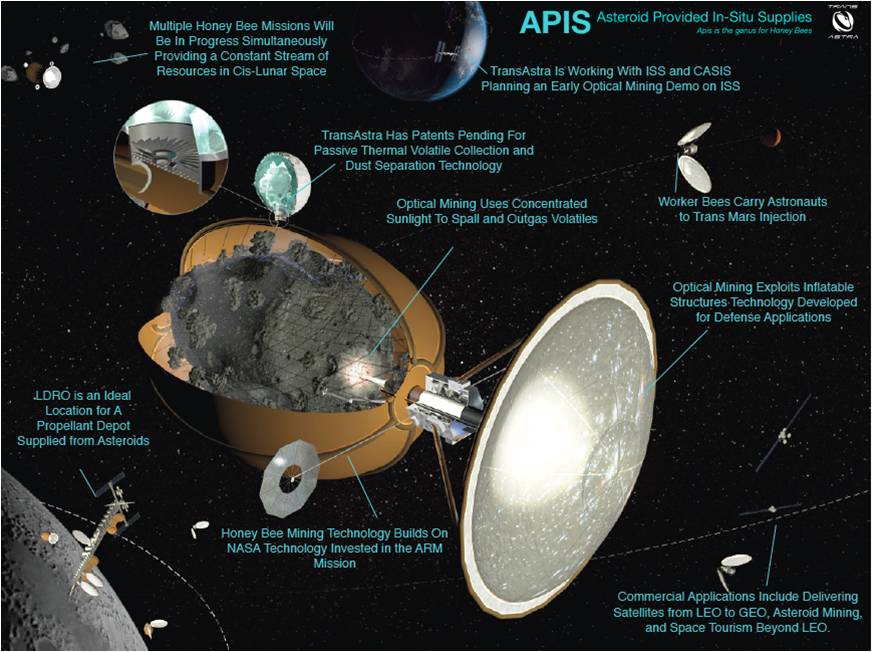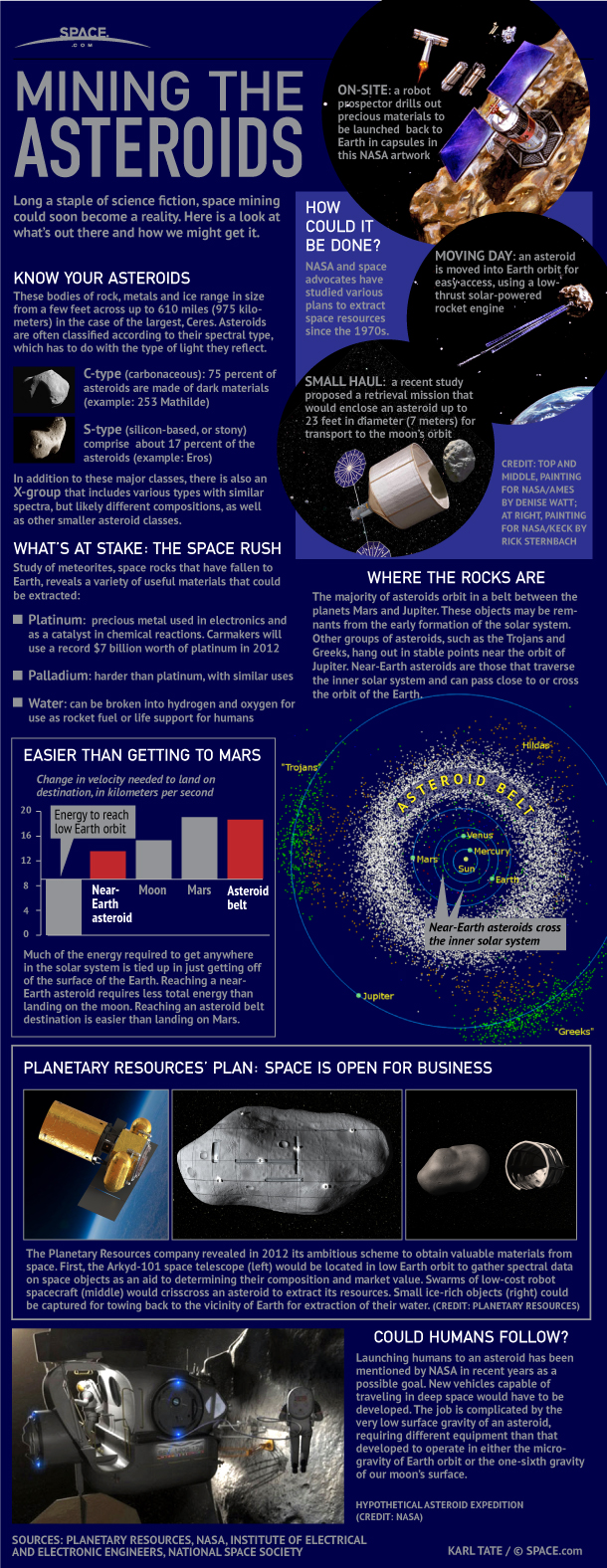Asteroid-Mining Plan Would Bake Water Out of Bagged-Up Space Rocks

PASADENA, Calif. — A new way to harvest asteroid resources is being eyed as a possible game changer for space exploration.
The patent-pending innovation, called "optical mining," could allow huge amounts of asteroid water to be tapped, advocates say. This water, in turn, could provide relatively cheap and accessible propellant for voyaging spacecraft, lowering the cost of spaceflight significantly.
Development of the optical-mining idea has been funded by a NASA Innovative Advanced Concepts (NIAC) fellowship and grant, along with a small business contract. The concept — which is also known as the Asteroid Provided In-Situ Supplies plan, or Apis — was detailed here during a special NIAC session held on Sept. 2 during the American Institute of Aeronautics and Astronautics' (AIAA) Space 2015 meeting. [How Asteroid Mining Could Work (Infographic)]
Asteroid-mining business model
"We're putting together a business model … one that moves reusability into space and more commercial methods and practices into deep space," Apis principal investigator Joel Sercel, founder and principal engineer at ICS Associates Inc. and TransAstra, told Space.com.
Breaking space news, the latest updates on rocket launches, skywatching events and more!
Sercel said that Apis can support NASA's plans for human exploration by providing mission consumables and propellant for all missions of the agency's Evolvable Mars Campaign, including human exploration efforts to lunar orbit, crewed missions to near-Earth asteroids in their native orbits, exploration of the moon and exploration of Mars.
Sercel formerly worked at NASA's Jet Propulsion Laboratory in Pasadena, California, and was a lead innovator for the NASA Solar Technology Application Readiness (NSTAR) ion propulsion system. NSTAR powers NASA's Dawn spacecraft, which is currently orbiting the dwarf planet Ceres.
Loads of water
Sercel said that the optical-mining approach aims to excavate carbonaceous chondrite asteroid surfaces and drive water and other volatile materials out of this excavated material and into an enclosing, inflatable bag, all without the need for complex or impractical robotics.
The Apis plan involves harvesting up to 100 metric tons of water from a near-Earth asteroid, and taking the material to lunar orbit or other depot locations, using only a single SpaceX Falcon 9 rocket launch, Sercel added.
Apis team members have already performed computer simulations and lab experiments on meteorite samples to get a better idea of how to approach the intended work in space.
Light and heat
Sercel and his colleagues are using their large solar furnace at the White Sands Missile Range in New Mexico to shed light andheat onto the idea.
Since the late 1970s, researchers have used this furnace to simulate the sudden heat generated by a nuclear explosion. The furnace makes use of two primary sets of mirrors. One large, flat set can pivot around to seize the rays of the sun and direct them though a shutter system onto the second set of mirrors, which, in turn, focuses the light and heat onto the target.
In the September-October time frame, Sercel said, the Apis team will do proof-of-concept experiments at the White Sands facility. Hardware brought to the test site will hold cantaloupe-sized asteroid simulant targets that will be superheated by reflected and concentrated sunlight.
In-space spalling
The products of interest to Sercel are volatiles, especially water. Volalites can be harvested from rock by a process called spalling, in which tiny, explosive pops of expanding gas drive out particles and gas.
Sercel said that the New Mexico tests could show that highly concentrated optical energy excavates the surface of material in a controlled way, analogous to how intense lasers can ablate surfaces, constantly exposing new material and forcing water out of the spalled material.
"It actually digs holes and tunnels into the rock. The heat goes in, is absorbed in thin layers and drives out the volatiles in tiny, explosivelike pops that eject material in a controllable way," Sercel said. "We believe that highly concentrated sunlight can drill holes, excavate, disrupt and shape an asteroid while the asteroid is enclosed in a containment bag."
Solid ice
The Apis solar-thermal oven scheme makes use of thin-film inflatable structures stemming from work on NASA's Asteroid Redirect Mission (ARM). The ARM plan calls for plucking a boulder off a near-Earth asteroid using a robotic probe, then hauling this chunk of rock to lunar orbit, where it could be visited by astronauts. [NASA's Asteroid Capture Mission in Pictures]
But in the Apis case, the inflatable capture system is fabricated from high-temperature material and designed to fully enclose the target.
After the asteroid has been encapsulated and de-spun, an inflatable solar concentrator churns out direct solar-thermal energy to the asteroid surface. This heat is used to excavate the asteroid and force the water to outgas into the enclosing bag.
From there, the outgassing water is pumped into a passively cooled bag and stored as solid ice.
Storage bag
Up to 120 tons of water, collected over several months, could be stored in this manner, Sercel said. The Apis system would then transport the harvested water to lunar orbit, using some of the asteroid water as fuel for its onboard solar-thermal propulsion system.
Once in orbit around the moon, the water can be converted into consumables and propellant to support a variety of enterprises, including human exploration beyond low-Earth orbit.
"Apis is a commercially viable approach to the extraction, processing and delivery of water from asteroids to in-space assets," Sercel concluded.
Digging in
Along with Sercel, mining experts are digging into the question of how best to extract and exploit space resources.
"After many years of dead-end investigations trying unsuccessfully to adapt terrestrial mining techniques to extract resources from asteroids in the future, we are excited to finally participate in the development of what we consider the most feasible and effective technique to recover valuable volatile elements, such as space propellants, from asteroids," Angel Abbud-Madrid, director of the Center for Space Resources at the Colorado School of Mines in Golden, Colorado, told Space.com via email.
Both Abbud-Madrid and Chris Dreyer, also from the Center for Space Resources, are working with the TransAstra team on several projects exploring the optical-mining concept.
Leonard David has been reporting on the space industry for more than five decades. He is former director of research for the National Commission on Space and is co-author of Buzz Aldrin's 2013 book "Mission to Mars – My Vision for Space Exploration" published by National Geographic with a new updated paperback version released in May 2015. Follow us @Spacedotcom, Facebook or Google+. Originally published on Space.com.

Leonard David is an award-winning space journalist who has been reporting on space activities for more than 50 years. Currently writing as Space.com's Space Insider Columnist among his other projects, Leonard has authored numerous books on space exploration, Mars missions and more, with his latest being "Moon Rush: The New Space Race" published in 2019 by National Geographic. He also wrote "Mars: Our Future on the Red Planet" released in 2016 by National Geographic. Leonard has served as a correspondent for SpaceNews, Scientific American and Aerospace America for the AIAA. He has received many awards, including the first Ordway Award for Sustained Excellence in Spaceflight History in 2015 at the AAS Wernher von Braun Memorial Symposium. You can find out Leonard's latest project at his website and on Twitter.



